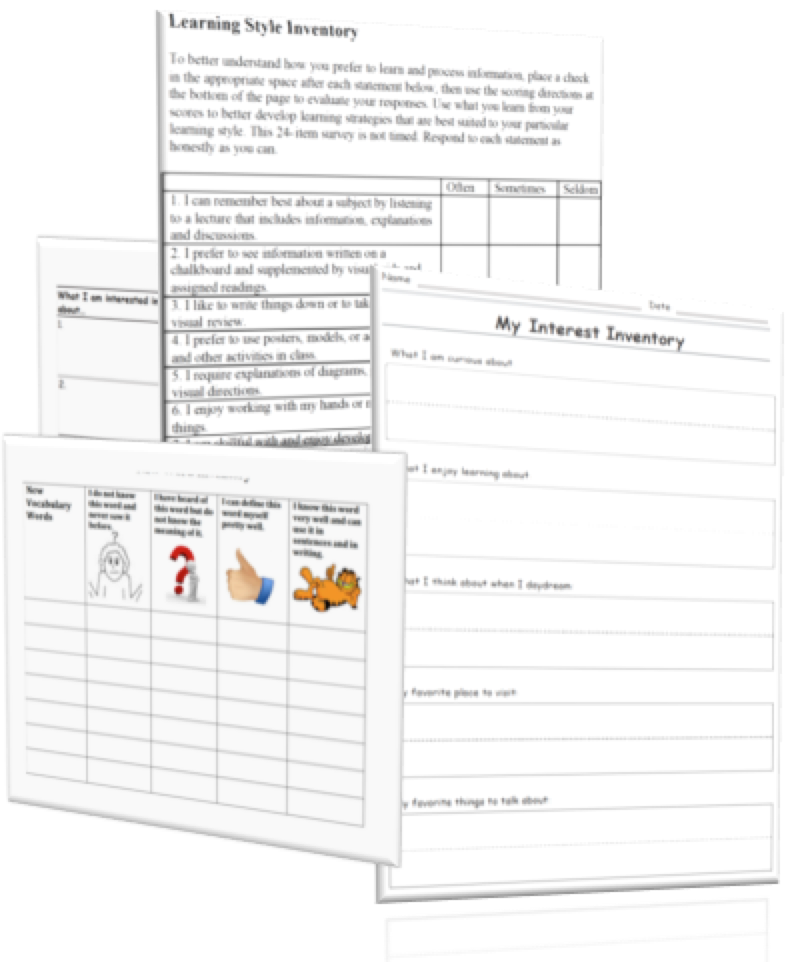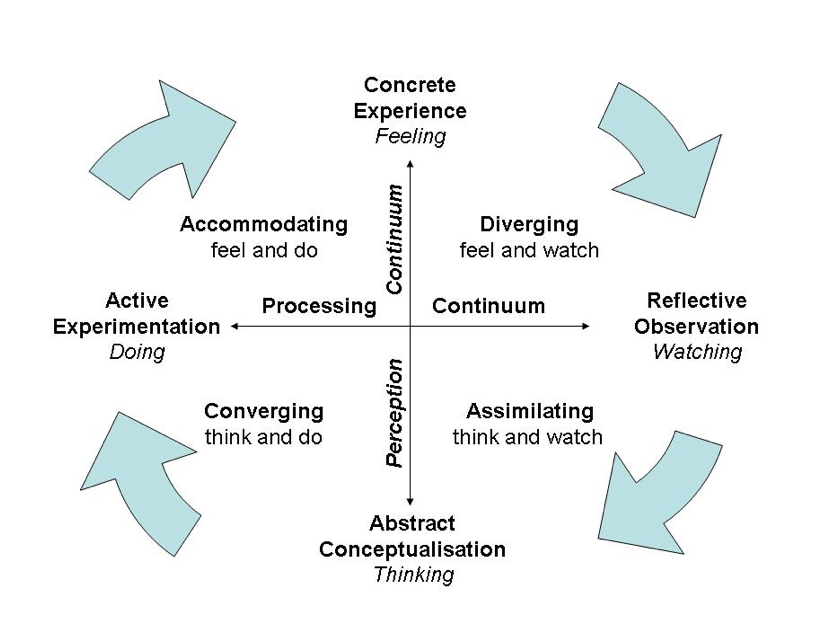Interests and Learning Styles
| Site: | Literacy Solutions On-Demand Courses |
| Course: | Cross-Cultural Communications and Understanding, Grades K-12 - No. ELL-ED-260 |
| Book: | Interests and Learning Styles |
| Printed by: | Guest user |
| Date: | Friday, December 19, 2025, 12:02 AM |
Description
no insert
1. Interest Inventories
Interest Inventories, Reading and Writing Surveys
Attitudes About Literacy and Learning
Reading and writing attitude surveys are simple ways to gather data about our students while garnering better behavior in social activities. They can give us a good indication of attitudes toward literacy and learning through administration of simple reading and writing questionnaires. Each questionnaire consists of 20 to 30 items that can be administered in whole class or in groups. They generally take about 10 minutes to administer, and students enjoy taking them because it is about their own preferences in a safe, non-judgmental venue. Norm-referenced tables are available as scoring aids to quantify results for grouping purposes.
The Internet is filled with interest and learning style inventories (learning style inventories are disussed next in this module). These inventories should be administered as early in the year as possible to appropriate materials, differentiate planning, allocate resources, and organize literature circle groups. Use of these inventories, one or all of them, can give us a wealth of information about our students to engage them with, while facilitating their academic success - it is a complete win/win!
In addition to the interest inventories named below, another way to find out about students' interests is to interview them. This can be time-consuming, but a nice way to confer and interact one-to-one with your students. Consider a paper and pencil survey, or create an electronic one using Google surveys, similar to what is housed below. Very young and/or struggling readers may need to have the questions read aloud to them. Here are some other tips for conducting personal interest surveys:
- Conduct a survey of reading interests in small groups.
- Collect five or six titles from the library from a few sources, folk tales, humor, fantasy, realistic fiction, etc.
- Display the books in front of the group and tell them you’re going to read the title and first page to see if they’re interested in the story or in reading it.
- After introducing the titles, read the first page of a selected book one-at-a-time and ask them to raise their hands if the story interests them. Use the fist to five approach, where a fist means not interested and five fingers raised means very interested.
Resources
Reading Interest Survey - basic
Reading Interest Survey – Google version
My Reading Preferences K-3 (see Course Objectives | Research | Materials folder)
Reading Attitude Survey, K-5 - Scholastic
Reading, Learning Style, and Attitude Interest Surveys
McKenna, M. C., & Kear, D.J. (1990). Elementary Reading Attitude Survey. From "Measuring attitudes toward reading: A new tool for teachers", The Reading Teacher, May 1990. International Reading Association, 800 Barksdale Road, Newark, DE 19714-8139.
Writing Attitude Survey:
Kear, D.J., Coffman, G.A., McKenna, M.C., & Ambrosio, A.L. (2000). Writing Attitude Survey. From: "Measuring attitude toward writing: a new tool for teachers", The Reading Teacher, 54.. International Reading Association, 800 Barksdale Road, Newark, DE 19714-8139.
Reading Styles Inventory
Carbo, M. (2003). Reading Styles Inventory. National Reading Styles Institute, Syosset, NY.
2. Interest Inventories
Informal Assessments
See The Teacher's Cafe for Inventories and other Assessments: http://theteacherscafe.com/Teacher-Directory/Reading-Assessments.htm
Also see the Course Objectives | Research | Materials folder, and the Reading Formative Assessments folder in this module
Informal reading assessments are qualitative assessments that measure the following:
- Grade level reading
- Fluency
- Comprehension

- Vocabulary
- Oral reading accuracy
Often ELLs will avoid reading altogether. They have come to dislike it for a number of reasons: they just don't like to read, are avoiding the act of reading altogether, or because classroom reading material is too difficult. They don’t like to be embarrassed reading aloud, getting "caught" not understanding what they read, and have simply become frustrated because the task of reading. Study after study has shown that students who read independently practice their reading skills and become better readers as a result. These are the motivated readers, motivated either by a good grade, the read itself, or because they are students who like to achieve. Struggling readers, different story.
Whether the child is a struggling reader or an unmotivated reader, finding his/her independent, instructional, and frustration reading levels is a necessary first step in motivating him/her to read. Equally as important, finding out what interests them in the topics they like to read about, genres (fiction, non-fiction, articles, editorials, car magazines, etc.). Administering an interest inventory at the beginning of the school year can help us to identify the reading materials likely to engage them, as well as identify follow-up activities to further engage and keep them reading and learning such as literature circles, book clubs, projects, and even writing topics for follow-up reading.
Interview and Reading Inventory Suggestions:
Student interviews: Students can interview one another and report back results, or teachers can interview them via survey or personal student-teacher conferences. Very young and/or struggling readers may need to have the survey questions read aloud to them, or one can be developed online using visuals and prompts. You might also conduct a survey of reading interests in small groups. Collect five or six titles from your library from a few different genres (folk tales, humor, fantasy, realistic fiction, etc.).
Conduct book reads yourself, or invite the school librarian or media specialist in to conduct a book read. Display the books in front of the group, showcasing the cover and backside pictures. Tell students what you're about to do, and follow with a reading of the title, first page or paragraph, and a few "blurbs" on the inside cover to get them interested. Don't give away the ending! Ask for a show of hands or a fist-to-five technique to let you know how many are interested in the book, and if the story interests them. After reviewing all of the books, immediately invite them up to check them out (have the library stamp or database on hand). A good reading attitude survey can be found in the Elementary Reading Attitude Survey by McKenna and Kear (1990).
After the Interview or Survey
Gather the inventory or interview data and create a file for each student. You can keep the data on an index card, sticky note, log on a clipboard, or in an online database. Use the data to place them in appropriately leveled books (as determined through benchmark assessments).
Give each student a copy of his/her quantified data so that they can be reminded of what their interests are, level of reading for independent and instructional, and any other information pertinent to their making proper independent choices for reading. Remember the ultimate goal: placing the right book in their hands so that they will want to read, and read on their own frequently.
References:
Taylor, B. M., Frye, B. J., & Maruyama, G. M. (1990). Time spent reading and reading growth. American Educational Research Journal, 27 (2), 351-362.
McKenna, M.D., & Kear, D. J. (1990). Measuring attitude toward reading: A new tool for teachers. The Reading Teacher, 43(9), 626-639. Retrieved July, 2009: http://faculty.rcoe.appstate.edu/koppenhaverd/f06/3030/readings/mckenna&kear.pdf
Keeping Students Motivated About Learning:
- Give students access to a wide choice of reading material and allow them to choose what they want to read.
- Provide a classroom library which has books on many reading levels, as well as magazines, newspapers, graphic novels, and comic books. In the absence of an extensive classroom library, schedule a weekly trip to the school library for students to select and check out books.
- Read aloud to students daily, and model good, effective oral reading with tone, intonation, and high engagement - be a good model of oral reading.
- Tape book reads and have students check out the book and the audio taped readings of them. Invite your administrators, counselors, and special area teachers (physical education, art, music, etc.) to record their reading of the book for students to check out (students will get a kick out of hearing their other teachers read). Students need to see and hear good role models engaged in reading.
- Invite special area teachers to read to your students live when possible.
Adapted from: Using Interest Inventories with Struggling and Unmotivated Readers, By Arleen P. Mariotti
3. Learning Style Inventories
Learning Style Inventories:
- Edutopia: What's Your Learning Style?
- Kolb's Learning Styles
- What's Your Learning Style?
- Memletics LS Questionnaire
Differentiating instruction also involves purposefully gathering and organizing data to create individual student learning profiles with. We administer these profiles in order to get to know our learners better, which then allows us to plan instruction and hence: differentiate. Learning profiles help us understand our students’ multiple intelligence strengths, their learning styles, what prior knowledge they have about a subject, what they’re interested in, how ready they are to learn something, what they are most challenged by, and what their learning limitations are if any.
Kolb’s research (1999) determined that we take in information through our senses, and some of us use more of one sense than another. Like our DNA, everyone’s sense and degree of sense used to interpret information varies. Seeing, hearing, speaking, smelling – our sense communicate information to our brains, and then share one dominant modality across the spectrum with which to best interpret and articulate information. Visual, auditory, and kinesthetic are all learning styles with specific characteristics. Here are some of them:
Visual Learner:
- Observe rather than act or speak
- Likes to read
- Uses graphics and/or pictures to memorize information
- Not easily distracted
- Struggles with only verbal instruction
- Uses good handwriting
- The Auditory Learner
- Enjoys reading aloud
- Enjoys speaking and verbally articulating
- Has difficulty with only written directions
- Likes to be read to
- Easily distracted by noise
- Is outgoing
- Enjoys listening
The Kinesthetic Learner:
- Enjoys problem solving and is generally good at it
- Problem solves using hands-on means
- Responds well to physical rewards
- Reading takes a back seat to hands-on activities
- Likes to try new things
- Taps a pencil or feet when reading or studying
Teaching to Interest, Preference, Culture, and Gender include the following:
- Topics or pursuits that evoke curiosity and passion in a learner; facets of learning that invite time and energy in pursuit of knowledge.
- Attributes that describe how a student learns best, to include learning style, intelligence preference, culture, and gender.
- Learning profiles to determine learning styles
- Preferences for learning are shaped by multiple and overlapping student factors that include learning style, intelligence, preference, culture, and gender.

Kolb’s Learning Styles and Experiential Learning Model (1999)
Kolb studies of experiential learning have six main characteristics:
- Learning is best conceived as a process, not in terms of outcomes.
- Learning is a continuous process grounded in experience.
- Learning requires the resolution of conflicts between opposing modes of adaptation to the world (learning is by its very nature full of tension).
- Learning is a holistic process of adaptation to the world.
- Learning involves transactions between the person and the environment.
- Learning is the process of creating knowledge that is the result of the transaction between social knowledge and personal knowledge.
Experiential learning has implications for all learners. Kolb's learning theory is based on a four-stage learning cycle, distinguishing it from individual learning style inventories. Each achieves the same in the end: data about how our students learn best, and under what circumstances for optimal differentiation.
